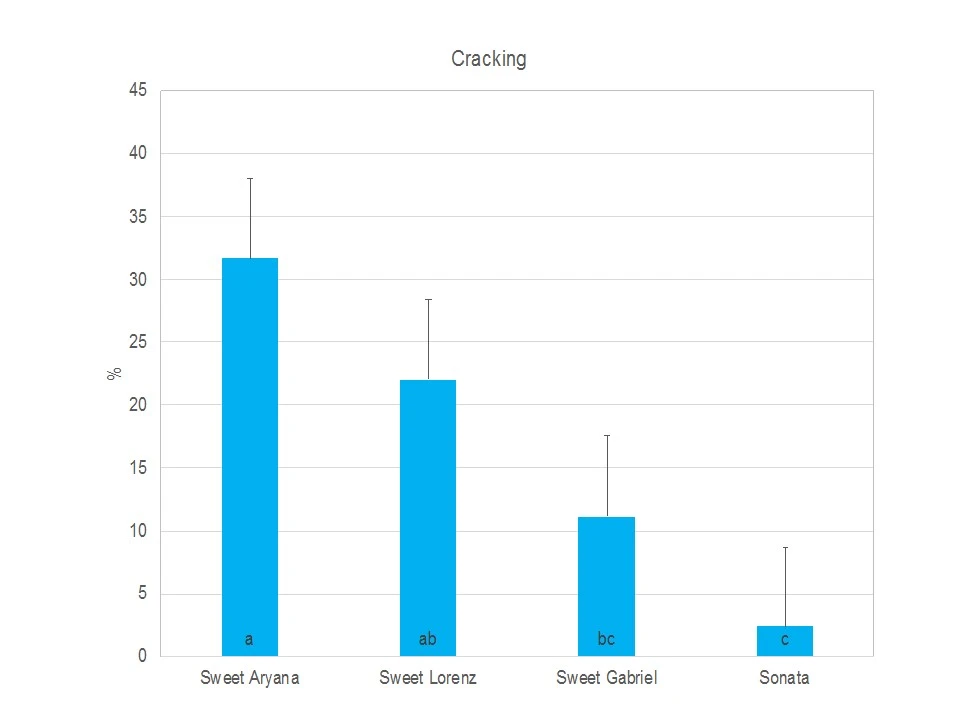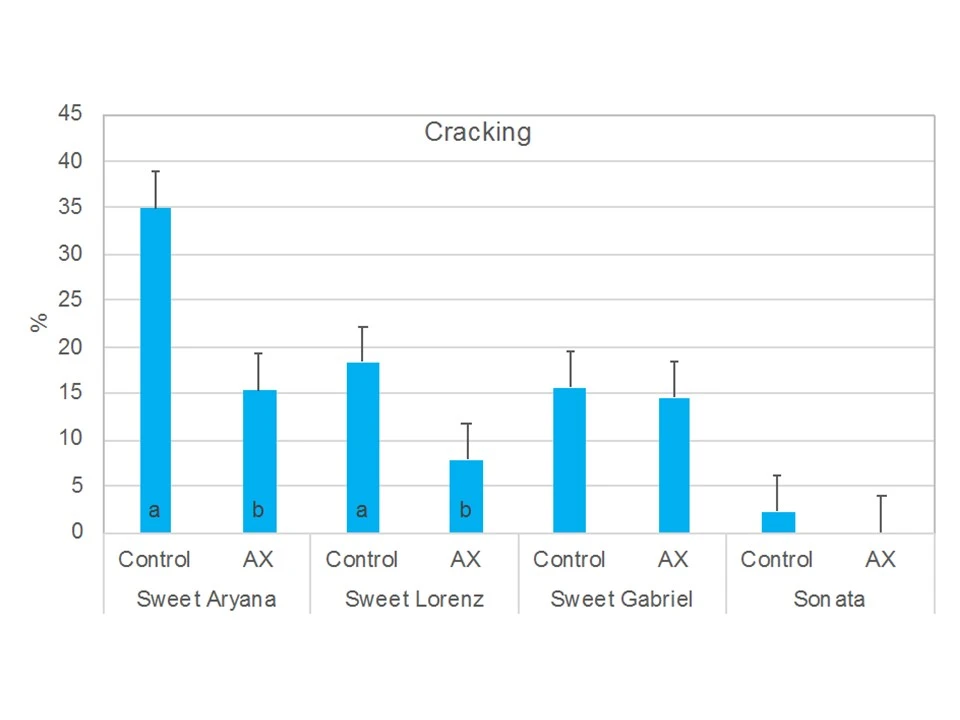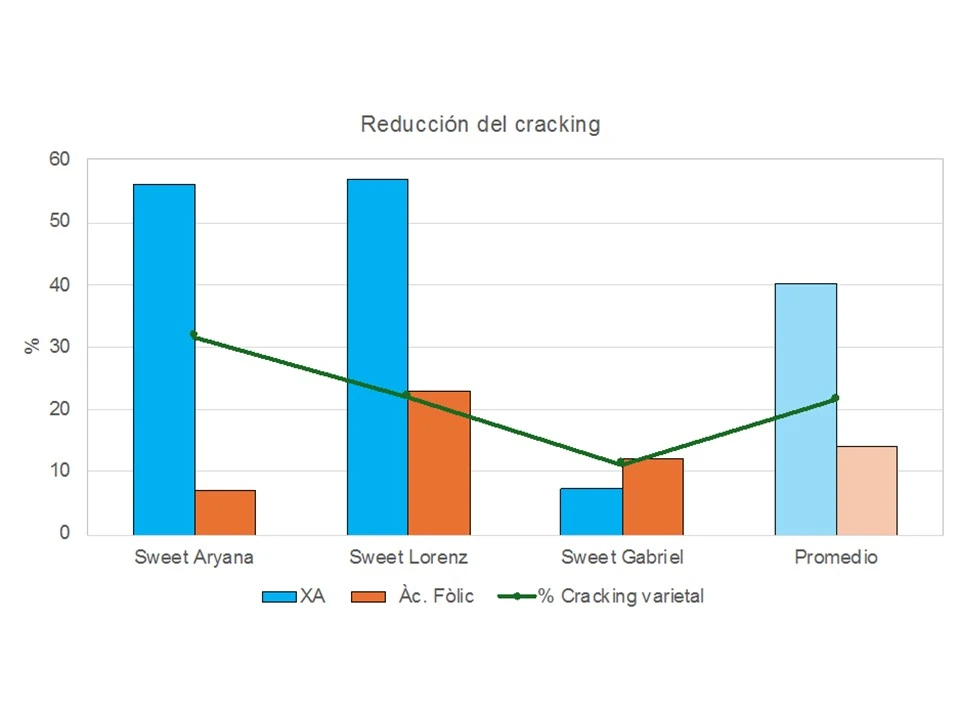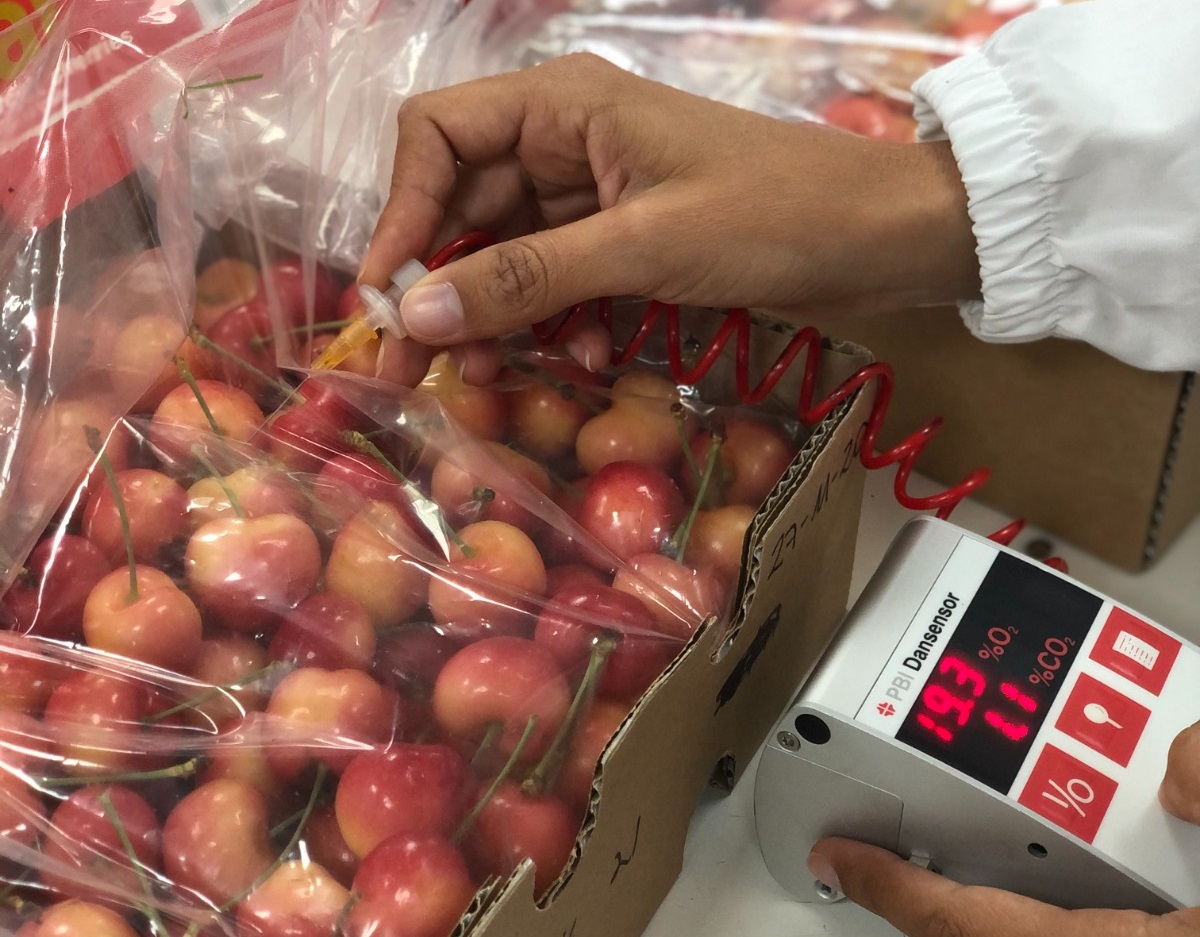Fruit cracking caused by rain is one of the main causes of production loss in sweet cherry cultivation worldwide. The Spanish project "CrackCirera" evaluated various strategies to mitigate this issue, focusing on three main approaches: selecting the plant material, using anti-rain covers, and applying products based on phytohormones and minerals.
The results showed that susceptibility to cracking varies significantly among different cherry varieties. Some cultivars, such as Sweet Aryana® and Sweet Lorenz®, exhibited more than 30% of fruit cracking in the field, whereas others, like Sonata and Sweet Gabriel®, had less than 5% of affected fruits.
Varietal differences and cracking resistance
 Figure 1. Daily and cumulative rainfall from March 1 to June 30, 2024 in the Actel plot. The harvest date for each variety is also shown.
Figure 1. Daily and cumulative rainfall from March 1 to June 30, 2024 in the Actel plot. The harvest date for each variety is also shown.
However, this difference is largely attributed to the varieties’ phenology: later-ripening varieties tend to escape the most intense rainy events, while early varieties are more exposed. To confirm this, researchers conducted laboratory-induced cracking tests, where even the late varieties showed a higher percentage of affected fruits.
Specifically, Sweet Lorenz® was the most susceptible (73%), while Sweet Aryana® demonstrated greater resistance, with only 13% of damaged fruits. This indicates that the lower cracking rate observed in the field for these varieties is not due to physicochemical properties that make the fruits more resistant but rather to their phenology, which helps them avoid periods of intense rainfall.
 Figure 2. Percentage of fruit affected by cracking for each variety evaluated in the Actel plot. Different letters indicate statistically significant differences between varieties (p < 0.05).
Figure 2. Percentage of fruit affected by cracking for each variety evaluated in the Actel plot. Different letters indicate statistically significant differences between varieties (p < 0.05).
Beyond cracking tolerance and yield, late-ripening varieties harvested closer to summer often have lower market prices than those harvested early in the season. Therefore, depending on the commercial strategy, growers must assess whether an early variety, more susceptible to cracking losses but sold at a higher price, is a better choice.
Effectiveness of rain covers and treatments
 Figure 3. Percentage of fruit affected by cracking and kg/tree without cracking for each variety and treatment evaluated in the Actel plot. Data are not shown for the Sonata variety, as virtually no cracking occurred even in the control treatment. No significant differences were observed between treatments (p > 0.05).
Figure 3. Percentage of fruit affected by cracking and kg/tree without cracking for each variety and treatment evaluated in the Actel plot. Data are not shown for the Sonata variety, as virtually no cracking occurred even in the control treatment. No significant differences were observed between treatments (p > 0.05).
The use of rain covers proved highly effective in reducing cracking, with an average reduction of 40% in damaged fruits, reaching over 50% for varieties more exposed to pre-harvest rainfall. This protective system was particularly beneficial for Sweet Aryana® and Sweet Lorenz®, which were exposed to rain in the weeks leading up to harvest, while it had no significant effect on Sweet Gabriel®, which did not experience notable rainfall before harvest.
Regarding treatments applied to enhance resistance to cracking, no particularly remarkable results were observed. However, the use of folic acid led to an average reduction of 10% in cracking incidence.
Impact on fruit quality and cost analysis
 Figure 4. Percentage of fruits affected by cracking for each variety without and with anti-raining net (AX), evaluated in the Actel plot. For each variety, different letters indicate statistically significant differences between treatments (p < 0.05).
Figure 4. Percentage of fruits affected by cracking for each variety without and with anti-raining net (AX), evaluated in the Actel plot. For each variety, different letters indicate statistically significant differences between treatments (p < 0.05).
Post-harvest analysis showed that none of the tested strategies had negative effects on fruit quality. However, some covers influenced fruit size and weight: for “Tiogacov” variety, rain covers increased fruit size and firmness, while for Sweet Lorenz®, slight variations were recorded in sugar content and hardness.
The project also assessed different rain cover materials, analyzing their resistance to climatic events as well as installation and maintenance costs. Under the studied conditions, mono-row covers had an average cost 50% higher than monoblock covers but provided greater flexibility for selectively protecting trees.
Additionally, the covers influenced temperature and humidity in the orchard, with variations ranging from -0.5°C to +1°C.
 Figure 5. Percent reduction in cracking with anti-rain net (XA), folic acid applications, and percentage of cracking observed for each variety in control trees evaluated in the Actel plot. Mean values are given for the three varieties with the greatest cracking problems. Data for the Sonata variety are not shown because virtually no cracking occurred even in the control treatment.
Figure 5. Percent reduction in cracking with anti-rain net (XA), folic acid applications, and percentage of cracking observed for each variety in control trees evaluated in the Actel plot. Mean values are given for the three varieties with the greatest cracking problems. Data for the Sonata variety are not shown because virtually no cracking occurred even in the control treatment.
Conclusion
In summary, the “CrackCirera” project in Spain highlighted the importance of selecting the right varieties and rain protection systems to minimize production losses caused by sweet cherry cracking. These findings can help guide cherry growers toward more informed decisions, especially during the initial planting phases.
Source: J. Lordan, C. Faro, C. López–Cristoffanini, G. Echeverria (2025). CrackCirera: estrategias para la reducción del cracking en cereza. Revista de Fruticultura n.103. https://fruticultura.quatrebcn.es/fruticultura-103
Images: Lordan et al., 2025; SL Fruit Service
Andrea Giovannini
Università di Bologna
Italian Berry - Tutti i diritti riservati

















